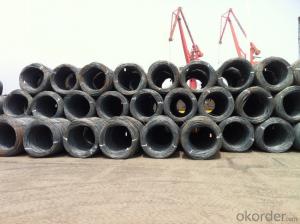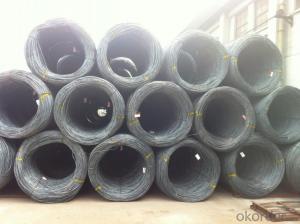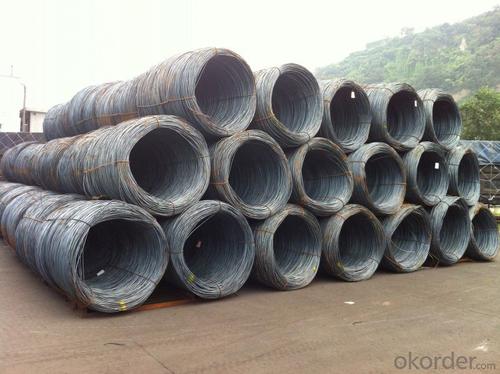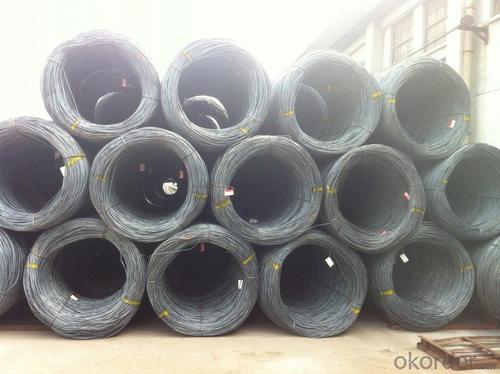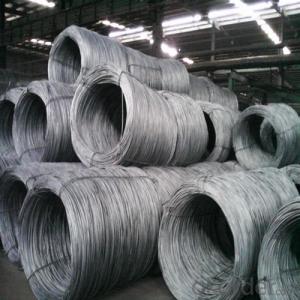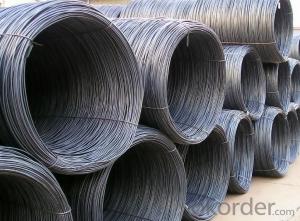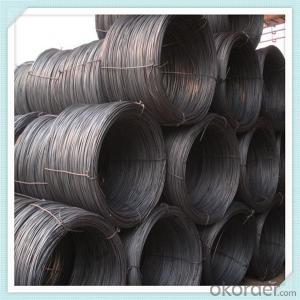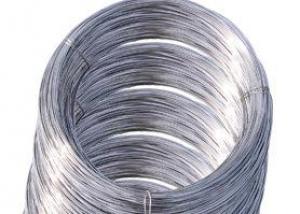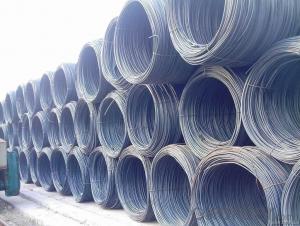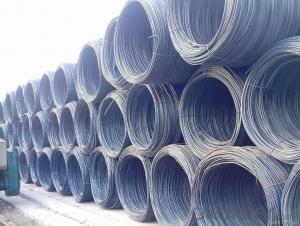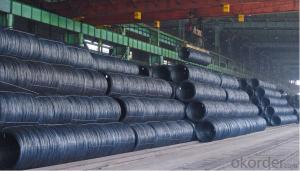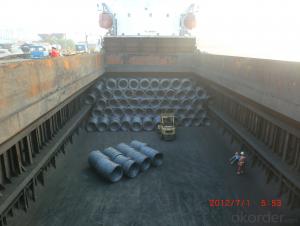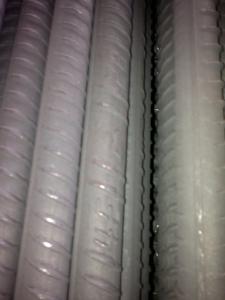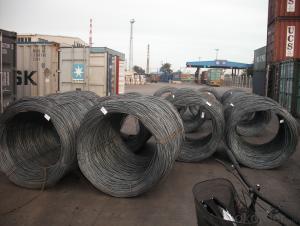Hot Rolled Wire rods with highest quality and lowest price
- Loading Port:
- Tianjin
- Payment Terms:
- TT OR LC
- Min Order Qty:
- 25 m.t.
- Supply Capability:
- 10000 m.t./month
OKorder Service Pledge
OKorder Financial Service
You Might Also Like
Product Description:
OKorder is offering Carbon Steel Wire Rod at great prices with worldwide shipping. Our supplier is a world-class manufacturer of steel, with our products utilized the world over. OKorder annually supplies products to European, North American and Asian markets. We provide quotations within 24 hours of receiving an inquiry and guarantee competitive prices.
Product Applications:
Carbon Steel Wire Rod are ideal for structural applications and are widely used in the construction of buildings and bridges, and the manufacturing, petrochemical, and transportation industries.After hot-rolled the products shaped into coil and delivery as finished product, including round, square, rectangular, hexagonal and so on. Since most of the products are round, it is generally called wire rod. Carbon steel wire rod is widely used in construction and manufacturing. Carbon steel wire rod is mainly used for reinforcement of reinforced concrete and welded structure or reprocessed (roberts , nail, etc.) materials, especially used to produce wire drawing, welding electrode, nails, spring, electronic, precise machinery parts and so on.
Product Advantages:
OKorder's Carbon Steel Wire Rod are durable, strong, and resist corrosion.
Main Product Features:
· Premium quality
· Prompt delivery & seaworthy packing (30 days after receiving deposit)
· Corrosion resistance
· Can be recycled and reused
· Mill test certification
· Professional Service
· Competitive pricing
Product Specifications:
Chemical Composition:
Please kindly find our chemistry of our material based on SAE1006/SAE1008 as below for your information
Grade | Chemical Composition (%) | |||||
C | Mn | S | P | Si | B | |
SAE1006B | 0.03~O.07 | 0.32max | 0.045max | 0.040max | 0.30max | 0.0008min |
Mechanical properties | ||||||
Yield strength(N/mm2) | Tensile strength(N/mm2) | Elongation (%) | ||||
250-280 | 350-380 | ≥32 | ||||
Grade | Chemical Composition (%) | |||||
C | Mn | S | P | Si | B | |
SAE1008B | 0.10max | 0.3~0.50 | 0.050max | 0.040 max | 0.15max | 0.0008 min |
Mechanical properties | ||||||
Yield strength(N/mm2) | Tensile strength(N/mm2) | Elongation (%) | ||||
≥195 | 315-430 | ≥30 | ||||
FAQ:
Q1: Why buy Materials & Equipment from OKorder.com?
A1: All products offered byOKorder.com are carefully selected from China's most reliable manufacturing enterprises. Through its ISO certifications, OKorder.com adheres to the highest standards and a commitment to supply chain safety and customer satisfaction.
Q2: How do we guarantee the quality of our products?
A2: We have established an advanced quality management system which conducts strict quality tests at every step, from raw materials to the final product. At the same time, we provide extensive follow-up service assurances as required.
Q3: How soon can we receive the product after purchase?
A3: Within three days of placing an order, we will begin production. The specific shipping date is dependent upon international and government factors, but is typically 7 to 10 workdays.
Image
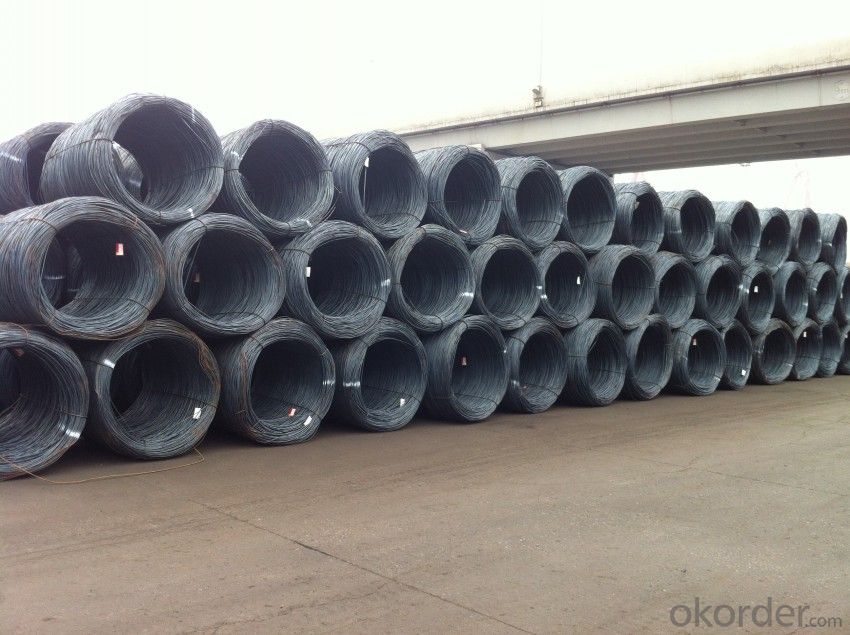
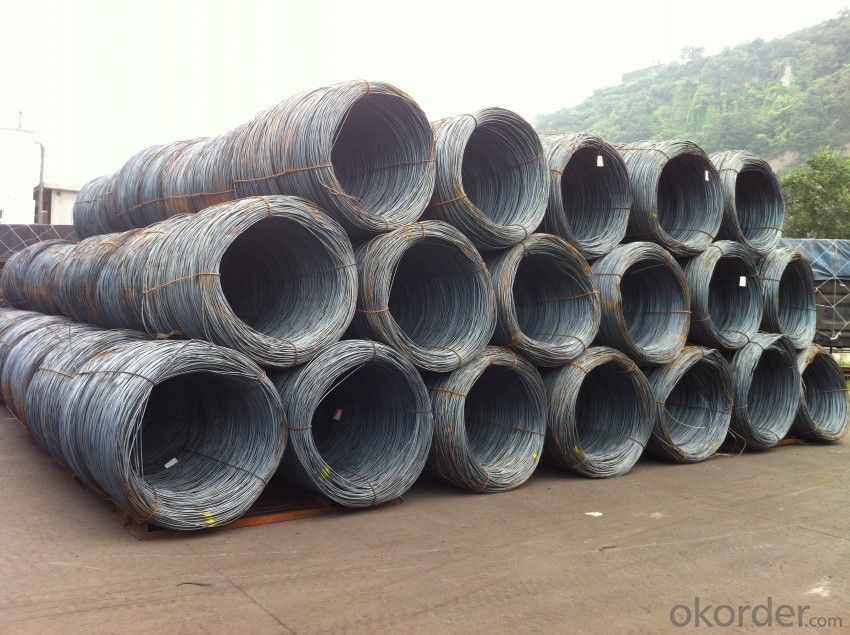
- Q: How does the fatigue strength of steel wire rod vary with different heat treatment processes?
- The fatigue strength of steel wire rod can vary significantly depending on the heat treatment processes employed. Heat treatment involves subjecting the steel wire rod to specific heating and cooling processes to alter its microstructure and mechanical properties. One common heat treatment process used to enhance the fatigue strength of steel wire rod is quenching and tempering. During this process, the wire rod is heated to a high temperature and then rapidly cooled (quenched) to achieve a hardened microstructure. This results in an increase in the wire rod's fatigue strength as the hardened structure provides improved resistance against fatigue failure. The subsequent tempering process is performed by reheating the wire rod to a lower temperature and cooling it slowly, which helps to relieve internal stresses and improve the wire rod's toughness while maintaining an optimum balance of strength and ductility. On the other hand, if the steel wire rod is subjected to a lower temperature heat treatment process, such as annealing, the fatigue strength may be reduced. Annealing involves heating the wire rod to a specific temperature and allowing it to cool slowly, often in a controlled atmosphere. This process is used to soften the wire rod, relieve internal stresses, and improve its machinability and formability. However, the resulting softer microstructure may lead to a decrease in fatigue strength compared to quenched and tempered wire rod. In summary, the fatigue strength of steel wire rod can be enhanced through heat treatment processes such as quenching and tempering, which result in a hardened microstructure. Conversely, heat treatment processes like annealing can reduce the fatigue strength by producing a softer microstructure. Therefore, the selection of heat treatment processes plays a crucial role in determining the fatigue strength of steel wire rod.
- Q: How is steel wire rod used in the manufacturing of wire rope decking?
- Steel wire rod is used as the primary material in the manufacturing of wire rope decking. It is typically formed into strands of wire rope that are then woven or twisted together to create a strong and durable decking material. The steel wire rod provides the necessary strength, flexibility, and resistance to corrosion, making it ideal for supporting heavy loads and ensuring the safety of the decking structure.
- Q: How is steel wire rod used in the manufacturing of wire forms for medical devices?
- Steel wire rod is an essential component in the manufacturing of wire forms for medical devices. It serves as the raw material that is processed and transformed into various wire forms used in medical applications. Firstly, the steel wire rod undergoes a series of processes such as drawing, annealing, and coating to improve its properties and make it suitable for medical device applications. Drawing involves reducing the diameter of the wire rod through a series of dies, resulting in a thinner and more flexible wire. Annealing is a heat treatment process that enhances the wire's ductility and removes any residual stresses. Coating, such as electroplating or passivation, is applied to the wire to provide corrosion resistance and improve biocompatibility. Once the steel wire rod is processed, it can be used to manufacture a wide range of wire forms for medical devices. These wire forms include springs, coils, guidewires, catheters, and various surgical instruments. Springs made from steel wire rod are used in devices such as implantable cardiac pacemakers, where they provide mechanical support and help regulate the heart's rhythm. Coils and guidewires made from steel wire rod are used in minimally invasive procedures, such as stenting or catheterization, where they provide flexibility and maneuverability to navigate through blood vessels or other body structures. The high strength and durability of steel wire rod make it suitable for applications where reliability and precision are critical, such as orthopedic implants or surgical instruments. It can be formed into intricate shapes and sizes, allowing for the production of customized wire forms that meet the specific requirements of different medical devices. Additionally, steel wire rod's biocompatibility, when properly coated or treated, ensures that it does not react adversely with the human body, making it safe for use in medical applications. In summary, steel wire rod plays a crucial role in the manufacturing of wire forms for medical devices. Through various processing techniques, it is transformed into springs, coils, guidewires, and other wire forms that provide mechanical support, flexibility, and precision in medical applications. Its strength, durability, and biocompatibility make steel wire rod an ideal choice for the production of wire forms used in medical devices.
- Q: How is steel wire rod used in the manufacturing of wire grids?
- Steel wire rod is used in the manufacturing of wire grids as it serves as the raw material for creating the wire mesh structure. The wire rod is first processed through various techniques such as drawing, annealing, and galvanizing to obtain the desired thickness, strength, and corrosion resistance. Once prepared, the wire rod is then woven or welded to form the wire grid, which is commonly used in industries such as construction, agriculture, and transportation for applications like fencing, shelving, and partitioning.
- Q: How is steel wire rod used in the manufacturing of wire forms for window screens?
- The manufacturing of wire forms for window screens relies heavily on steel wire rod. This material serves as the fundamental element for constructing the wire mesh structure that makes up the screen. To start, careful consideration is given to the selection of the steel wire rod based on its quality and properties. The rod must possess specific qualities such as tensile strength, elasticity, and resistance to corrosion in order to ensure the durability and longevity of the window screen. Once the appropriate steel wire rod is obtained, it undergoes a series of manufacturing steps. Initially, the rod is thoroughly cleaned and then passed through a series of dies to reduce its diameter to the desired size. This process, known as wire drawing, is essential for achieving a finer wire that can be easily shaped into the desired form. Following wire drawing, the steel wire typically undergoes further processing through galvanization or coating. This step involves the application of a protective layer of zinc or other coatings to enhance the wire's resistance to corrosion and prolong its lifespan. The galvanized or coated wire is then subjected to additional processing to eliminate any excess coating and ensure a smooth surface. Ultimately, the processed steel wire is prepared for the formation of window screens. The wire is fed into wire forming machines, where it is shaped into the desired form, such as a rectangular or square mesh pattern. With great care, the wire is woven or welded together to create a robust and secure structure capable of withstanding external forces and effectively guarding against insects and debris. In conclusion, steel wire rod plays a vital role in the production of wire forms for window screens. It provides the necessary strength, durability, and resistance to corrosion required for a top-quality screen. Through various manufacturing processes, the steel wire rod is transformed into a finely drawn wire and then shaped into the desired form, resulting in a dependable and functional window screen.
- Q: How is steel wire rod used in construction?
- Steel wire rod is commonly used in construction for various purposes. It is primarily used as a reinforcement material in concrete structures, such as beams, columns, and slabs, to enhance their strength and durability. Steel wire rod is also utilized to create welded mesh panels, which are used in the construction of walls, fences, and other structures. Additionally, it is employed in the production of pre-stressed concrete, which is used in the construction of bridges and other large-scale infrastructure projects.
- Q: What are the different inclusion testing methods for steel wire rod?
- Some of the different inclusion testing methods for steel wire rod include optical microscopy, scanning electron microscopy (SEM), energy-dispersive X-ray spectroscopy (EDS), and ultrasonic testing. Optical microscopy allows for visual examination of the wire rod to identify any inclusions. SEM and EDS provide more detailed analysis by using electron beams and X-ray detectors to determine the composition and morphology of the inclusions. Ultrasonic testing uses sound waves to detect and analyze any internal defects or inclusions within the wire rod.
- Q: How is steel wire rod used in the manufacturing of wire forms for filtration systems?
- Steel wire rod is an essential component in the manufacturing of wire forms for filtration systems. The wire rod serves as the primary raw material for producing wires of various diameters and strengths, which are then shaped into specific forms used in filtration systems. To begin the manufacturing process, the steel wire rod is first carefully selected based on its composition, mechanical properties, and desired characteristics. This ensures that the wire rod is suitable for the specific filtration system requirements, such as resistance to corrosion, high tensile strength, and durability. Once the appropriate steel wire rod is chosen, it undergoes a series of manufacturing steps to transform it into wire forms for filtration systems. The wire rod is first cleaned and descaled to remove any impurities or surface contaminants that may affect its performance. It is then heated to a specific temperature to make it more malleable and easier to shape. The heated wire rod is then passed through a series of dies or molds, which give it the desired shape and dimensions for the wire forms used in filtration systems. The wire may be drawn through multiple dies to achieve the desired diameter and strength required for effective filtration. After shaping, the wire forms go through additional processes like annealing, which involves heating and slowly cooling the wire to relieve any stresses and improve its ductility. This step ensures that the wire forms can withstand the demands of filtration systems, such as high pressure or constant use. Once the wire forms are manufactured, they can be further processed or assembled into complete filtration systems. For example, the wire forms may be welded or joined together to create mesh screens or filter elements, which are then integrated into the overall filtration system design. Overall, steel wire rod plays a crucial role in the manufacturing of wire forms for filtration systems. Its versatility, strength, and ability to be shaped and transformed into various forms make it an ideal material for producing wires that meet the specific requirements of filtration systems. Whether it's for removing contaminants from liquids or gases, steel wire rod ensures the durability and effectiveness of filtration systems in a wide range of industries.
- Q: How is the demand for steel wire rod influenced by global economic trends?
- The demand for steel wire rod is greatly affected by global economic trends, as it is an essential raw material in various industries like automotive, construction, and manufacturing. Any changes in the global economic landscape can directly impact the demand for steel wire rod. In times of economic growth and industrial expansion, there is usually an increase in the demand for steel wire rod. This is because more construction projects, infrastructure development, and manufacturing output require large amounts of steel wire rod for purposes such as reinforcing concrete, electrical wiring, and fastening. Conversely, during economic downturns or recessions, the demand for steel wire rod tends to decrease. Reduced construction projects, decreased consumer spending, and lower manufacturing activities result in a reduced need for steel wire rod. Industries heavily reliant on steel wire rod, such as automotive and construction, often experience a decline in demand during these periods. Global economic trends also play a vital role in determining the prices of steel wire rod. Changes in currency exchange rates, trade policies, and supply and demand dynamics can impact the cost of raw materials, transportation, and production, which subsequently affects the price of steel wire rod. For example, increased trade tensions between countries can lead to tariffs or trade restrictions, affecting the availability and cost of steel wire rod in global markets. Moreover, global economic trends can influence the geographical distribution of steel wire rod production and consumption. As countries undergo shifts in economic growth, emerging markets may see a surge in demand for steel wire rod due to their expanding infrastructure and construction activities. This can result in the redistribution of production facilities and investments in these regions to meet the growing demand. In conclusion, the demand for steel wire rod is heavily influenced by global economic trends. It is crucial for stakeholders in the steel industry to understand these trends and their impact on industries that rely on steel wire rod in order to effectively manage their production, pricing, and market strategies.
- Q: What are the different types of steel wire rod surface cleaning methods for wire galvanizing?
- Wire galvanizing requires the use of various steel wire rod surface cleaning methods to eliminate impurities and contaminants. These methods are specifically designed to prepare the wire rod for the galvanizing process. One commonly used technique is acid pickling, which involves immersing the wire rod in a bath containing hydrochloric acid or sulfuric acid. The acid effectively dissolves mill scale, rust, and other contaminants, leaving the wire rod clean and ready for galvanizing. Another method, mechanical descaling, employs mechanical means such as abrasive brushes or shot blasting to physically eliminate surface impurities. This method is ideal for wire rods with heavy scale or stubborn contaminants that cannot be easily removed through acid pickling alone. Additionally, there is the electrolytic cleaning method, which utilizes an electric current to eliminate surface impurities. The wire rod is submerged in an electrolyte solution, and the electric current causes the impurities to migrate away from the wire rod towards the opposite electrode. This method is typically employed for wire rods with a thin layer of oxide or other surface contaminants. Lastly, mechanical cleaning involves using mechanical means like wire brushing or sanding to scrub the wire rod's surface and eliminate any impurities. This method is suitable for wire rods with light scale or surface contaminants that can be easily removed through mechanical means. Ultimately, the selection of a cleaning method depends on the specific requirements and condition of the wire rod. Each method has its own advantages and disadvantages in terms of effectiveness, cost, and environmental impact.
Send your message to us
Hot Rolled Wire rods with highest quality and lowest price
- Loading Port:
- Tianjin
- Payment Terms:
- TT OR LC
- Min Order Qty:
- 25 m.t.
- Supply Capability:
- 10000 m.t./month
OKorder Service Pledge
OKorder Financial Service
Similar products
Hot products
Hot Searches
Related keywords

